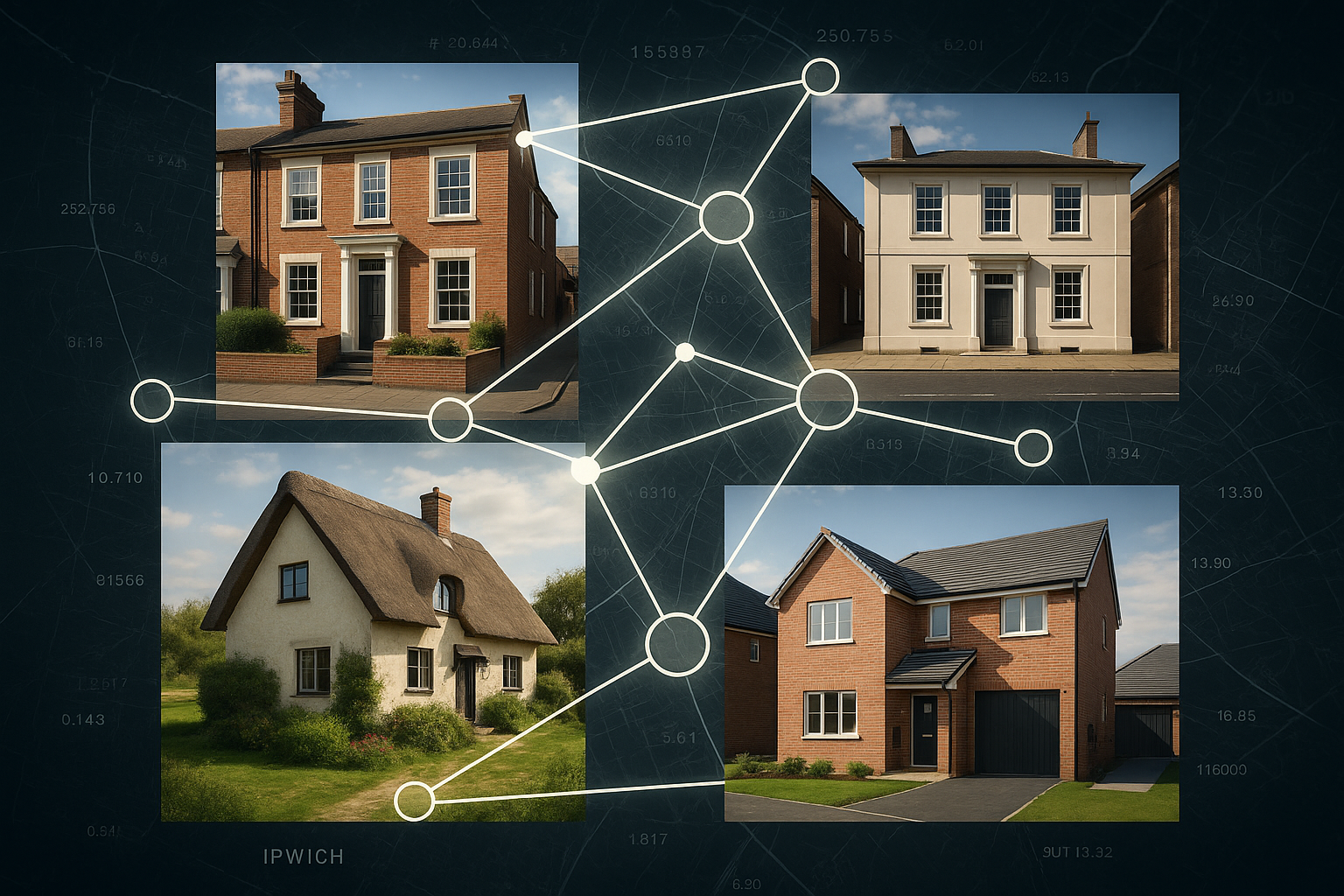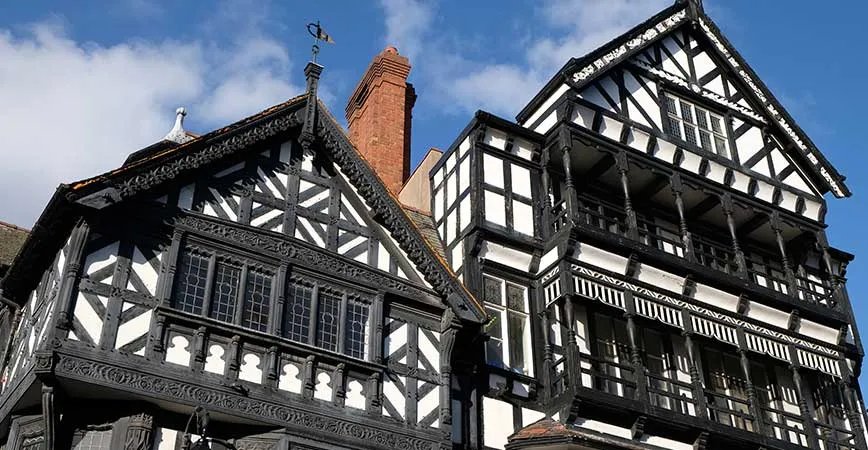
Historic Tudor timber-framed property typical of Suffolk's architectural heritage
Suffolk boasts one of England's richest architectural heritages, with over 20,000 listed buildings spanning nearly a millennium of construction history. From medieval timber-framed merchants' houses in Lavenham to elegant Georgian terraces in Bury St Edmunds, surveying period properties requires specialized knowledge that goes far beyond standard modern construction assessment.
As a chartered building surveyor with extensive experience across Suffolk's historic properties, I've learned that each period brings unique challenges, construction methods, and potential issues. Understanding these nuances is crucial for both surveyors and property buyers navigating Suffolk's period property market.
Suffolk's Architectural Timeline
To properly survey period properties, we must first understand Suffolk's architectural evolution. Each era brought distinct construction techniques, materials, and design philosophies that directly impact how we assess these buildings today.
Suffolk's Architectural Wealth
Suffolk's prosperity from the medieval wool trade created a unique concentration of high-quality historic buildings. The county has the highest density of timber-framed buildings in England, with over 10,000 examples dating from the 14th to 17th centuries.
Medieval Period (1066-1485)
Construction Characteristics
- • Massive oak timber frames with complex joinery
- • Wattle and daub infill panels
- • Thatched roofing with steep pitches
- • Minimal foundations, often just padstones
- • Single rooms with central hearths
Common Survey Issues
- • Beetle infestation in ancient timbers
- • Settlement due to inadequate foundations
- • Moisture penetration through daub panels
- • Structural alterations compromising integrity
- • Fire safety and building regulation compliance
Tudor Period (1485-1603)
The Tudor period represents the golden age of Suffolk timber framing, coinciding with the county's wool trade prosperity. This era produced some of England's finest timber-framed buildings, including the magnificent merchants' houses of Lavenham and Long Melford.
Tudor Construction Innovation
Structural Advances
- • Sophisticated joint systems (mortise and tenon)
- • Jetted upper floors for space maximization
- • Crown post and tie beam roof structures
- • Decorative close studding showing wealth
Material Developments
- • Seasoned oak from managed forests
- • Improved lime mortar and plaster
- • Early use of brick for chimneys and infill
- • Lead glazing in diamond-pane windows
Georgian Period (1714-1830)
The Georgian period brought classical architecture and brick construction to Suffolk. Towns like Bury St Edmunds expanded with elegant terraces and squares, while the Agricultural Revolution funded substantial country houses across the county.
Georgian Construction Principles
Structure
- • Load-bearing brick walls
- • Timber floor joists and beams
- • Welsh slate or clay tile roofs
Materials
- • Local red brick with lime mortar
- • Sash windows with crown glass
- • Cast iron for railings and gutters
Features
- • Symmetrical facades
- • Classical proportions
- • Decorative plasterwork
Specialist Survey Techniques for Period Properties
Surveying period properties requires adapted techniques and equipment to properly assess traditional construction without causing damage. Standard modern survey approaches often miss critical issues or, worse, can damage historic fabric.
Non-Destructive Investigation Methods
Visual Assessment Techniques
Detailed visual inspection using magnification, endoscopy, and photographic documentation to assess timber condition, joint integrity, and material deterioration without invasive testing.
Structural Movement Monitoring
Long-term monitoring of historic buildings using precision measurement to distinguish between ongoing settlement and seasonal movement patterns.
Understanding Traditional Construction Behavior
Period buildings were designed to move and flex in ways that would be concerning in modern construction. Understanding this behavior is crucial for accurate assessment and avoiding unnecessary alarm over normal characteristics.
Key Principle: Designed Movement
Traditional timber-framed buildings were designed to accommodate movement through flexible joints and connections. What appears as structural distress may actually be normal behavior after centuries of settling.
Expected Movement
- • Seasonal timber expansion/contraction
- • Gentle sagging of long span beams
- • Slight lean in timber-framed walls
- • Minor separation at traditional joints
Concerning Movement
- • Active progressive settlement
- • Sudden structural displacement
- • Crushing or failure of load-bearing elements
- • Recent movement indicated by fresh cracking
Common Issues in Suffolk Period Properties
Through decades of surveying Suffolk's historic buildings, certain issues appear with predictable frequency. Understanding these common problems helps both surveyors and owners anticipate maintenance needs and budget accordingly.
Timber-Related Problems
Insect Infestation
Historic timbers are susceptible to various wood-boring insects, particularly in Suffolk's humid climate.
Moisture-Related Decay
Traditional buildings are designed to 'breathe', but modern interventions often trap moisture causing decay.
Masonry and Pointing Issues
Suffolk's period buildings predominantly use lime-based mortars that require specific maintenance approaches. Modern cement pointing can cause significant damage to historic masonry through trapped moisture and differential movement.
Critical Issue: Inappropriate Modern Repairs
One of the most damaging issues we encounter is the use of hard cement mortars in buildings designed for lime mortar. This seemingly minor detail can cause extensive and expensive problems.
Problems Caused
- • Trapped moisture leading to frost damage
- • Salt crystallization in historic bricks
- • Differential movement creating cracks
- • Internal dampness and plaster failure
Solution Required
- • Complete removal of cement mortar
- • Replacement with appropriate lime mortar
- • Costs typically £80-120 per square meter
- • May require Listed Building Consent
Conservation Considerations
When surveying listed buildings or properties in conservation areas, understanding planning constraints and conservation requirements is essential. These considerations significantly impact both survey findings and subsequent repair recommendations.
Listed Building Grades and Implications
Grade I (2.5% of listed buildings)
Buildings of exceptional interest, sometimes considered to be internationally important. Examples include Lavenham Guildhall.
Grade II* (5.8% of listed buildings)
Particularly important buildings of more than special interest. Includes many Suffolk wool churches and manor houses.
Grade II (91.7% of listed buildings)
Buildings of special architectural or historic interest. The majority of Suffolk's listed buildings fall into this category.
Planning and Consent Requirements
Survey recommendations for period properties must consider the planning framework. What appears to be a straightforward repair may require Listed Building Consent or planning permission, significantly affecting costs and timescales.
When Consent is Required
Listed Building Consent Needed
- • Alterations affecting character or appearance
- • Replacement of windows or doors
- • Changes to roof materials or structure
- • Internal alterations affecting historic fabric
- • Installation of services affecting fabric
Permitted Maintenance
- • Like-for-like repairs using traditional materials
- • Routine maintenance and decoration
- • Emergency repairs to prevent further damage
- • Minor internal works not affecting structure
- • Garden and boundary maintenance
Budgeting for Period Property Maintenance
Period property ownership requires realistic budgeting for ongoing maintenance. Traditional construction methods and materials typically cost more than modern equivalents but are essential for preserving the building's integrity and value.
Typical Maintenance Costs (2024 Prices)
Roof Maintenance
Timber Repairs
Masonry Works
Choosing the Right Surveyor for Period Properties
Not all surveyors have experience with period properties. When selecting a surveyor for a historic building, specific expertise in traditional construction methods and conservation principles is essential for accurate assessment and appropriate recommendations.
Essential Surveyor Qualifications
Professional Qualifications
RICS Chartered Building Surveyor with demonstrated experience in historic building assessment
Specialist Knowledge
Training in traditional construction techniques, conservation principles, and historic building pathology
Local Experience
Proven track record surveying similar period properties in Suffolk with understanding of local materials and techniques
Professional Network
Connections with conservation specialists, traditional craftsmen, and planning consultants when needed
Conclusion
Surveying period properties in Suffolk requires a unique combination of technical expertise, historical knowledge, and practical experience. These buildings represent not just homes but irreplaceable pieces of architectural heritage that deserve informed, sensitive assessment.
Key Principles for Period Property Surveys
- Understand the building's history and original construction methods
- Distinguish between concerning defects and normal historic building behavior
- Consider conservation requirements and planning constraints in all recommendations
- Provide realistic cost assessments for traditional materials and skilled craftsmen
Whether you're surveying a medieval timber-framed cottage or a Georgian townhouse, the goal remains the same: providing owners with the knowledge needed to preserve these remarkable buildings for future generations while ensuring they remain safe, comfortable, and valuable homes.

Sarah Mitchell, MRICS
Senior Building Surveyor & Conservation Specialist
Sarah specializes in historic building surveys across Suffolk, with particular expertise in timber-framed construction and conservation area properties. She holds advanced qualifications in building conservation and regularly advises on Listed Building applications.
